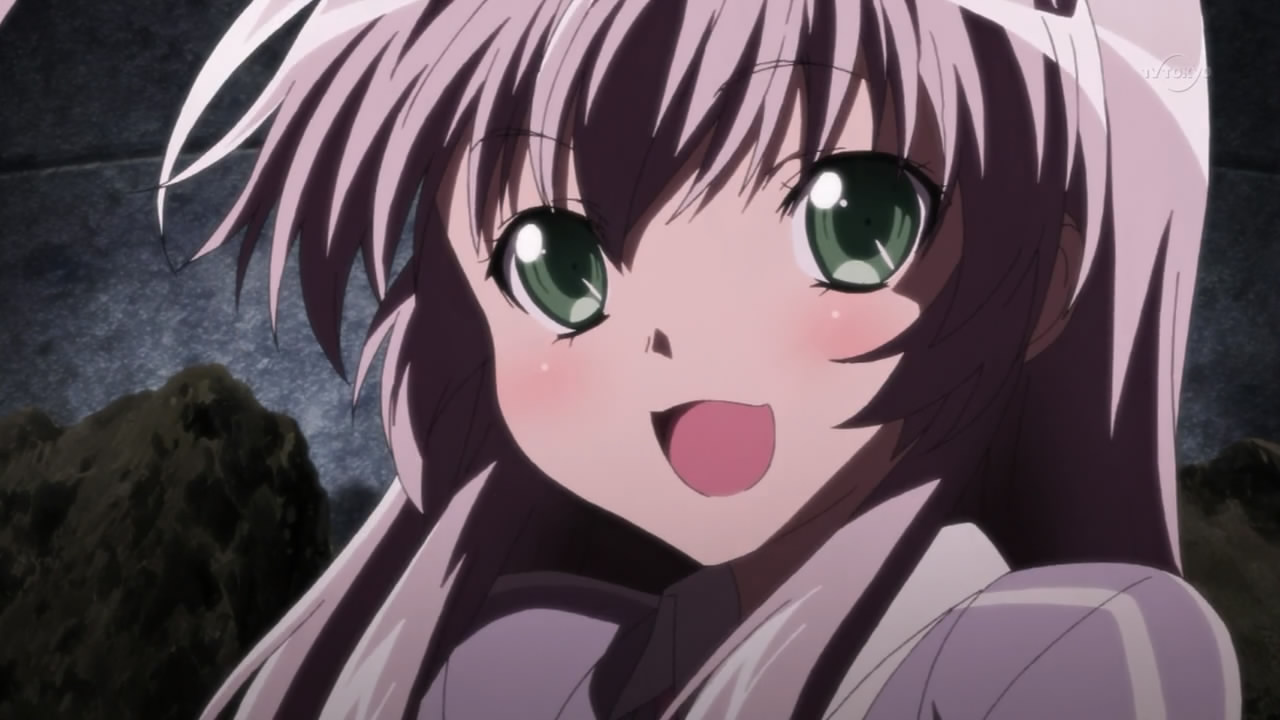Haiyore! Nyaruko-san Episode 10 References
"Allow me to explain." (0:27)
The Japanese line is "Setsumei shiyou" (説明しよう). Like in episode 9 at 8:35, this is referencing "Yatterman" (ヤッターマン), an anime series that aired from 1977 to 1979. During an episode, occasionally the narrator, or sometimes Boyakkii (ボヤッキー), another character in the series, will say "Setsumei shiyou" (説明しよう), "Allow me to explain", and interrupt the episode to explain something to the viewer about the current situation. This also occurs in the remake of "Yatterman" which aired from 2008 to 2009.
"If you'll crawl up to me, not even the Twelve Zodiac Temples or the Martial Arts Tournament will scare me!" (0:40)
The Japanese line is "Moshi, omae ga haiyotte kureru nara juunikyuu mo budoukai mo kowakunai" (もし、お前が這いよってくれるなら十二宮も武道会もこわくない). There are two references here:
* "Juunikyuu" (十二宮), "Twelve Zodiac Temples", is referencing "Saint Seiya", a manga series written by Kurumada Masami and published from 1986 to 1991. The Twelve Zodiac Temples are temples guarded by the twelve Gold Saints, the strongest knights in Athena's army who each correspond to a constellation in the zodiac.S2 There is also a story arc in the series called "Juunikyuu Hen" (十二宮編), "12 Zodiac Temples Chapter".S3
* "Budoukai" (武道会), "martial arts tournament", is referencing "Dragon Ball" (ドラゴンボール), a manga series written by Toriyama Akira (鳥山明) and published from 1984 to 1995. In the series there is a tournament that occurs once every three years called "Tenkaichi Budoukai" (天下一武道会), which roughly translates to "Strongest on Earth Martial Arts Tournament".S2
"Ludon Plateau" (0:51)
The Japanese line is "Ru... don... kou... gen..." (る・・・どん・・・こう・・・げん・・・). This is referencing "Rudon kougen" (ルドン高原), "Ludon Plateau", a location in the game "Romancing SaGa 2".S2
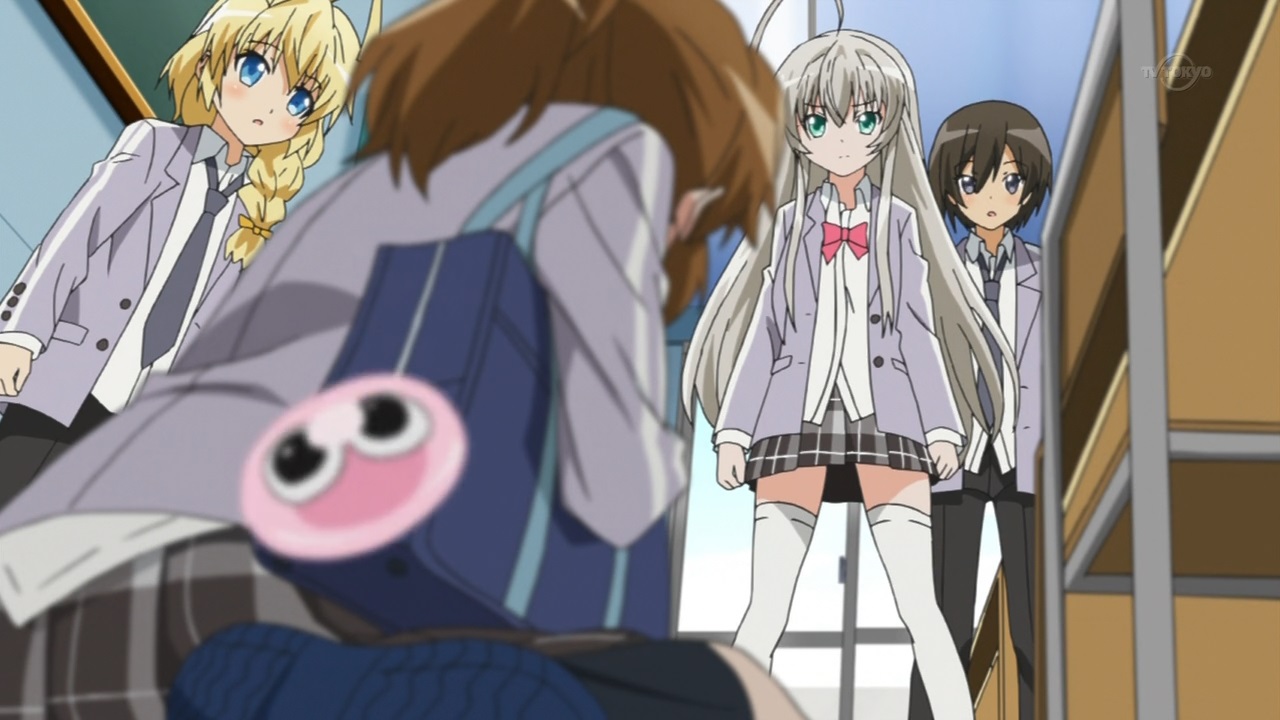
"I'm completely exhausted. I'm Compile exhausted. Bayoe~n." (3:20)
This scene is referencing "Puyo Puyo" (ぷよぷよ), a video game series released starting from 1991.
* The Japanese line is "Hirou konpai desu yo. Hirou konpairu desu yo. Bayoe~n desu yo" (疲労困憊ですョ。疲労コンパイルですョ。ばよえ~んですョ). "Hirou konpairu" (疲労コンパイル), translated here as "Compile exhausted", is a pun on "hirou konpai" (疲労困憊), which means "complete exhaustion", and "konpairu" (コンパイル), which means "compile". This is referencing "Konpairu" (コンパイル), "Compile", a Japanese video game company. In 1991, this company released "Puyo Puyo" (ぷよぷよ), the first game in the "Puyo Puyo" series.S2
* "Bayoe~n" (ばよえ~ん) is the name of a magic spell used by Arle Nadja (アルル・ナジャ) in the "Puyo Puyo" series.S1 Videos for reference:
https://youtu.be/Neej_WNhICY?t=332
https://youtu.be/NxJyJZbW4j4?t=9
https://youtu.be/08AEyhR9U5o?t=680
https://youtu.be/15z9V3v17Fo?t=418
* The pink object that falls in the foreground resembles a Puyo (ぷよ), a creature that appears in the "Puyo Puyo" series.S1 Image for reference:
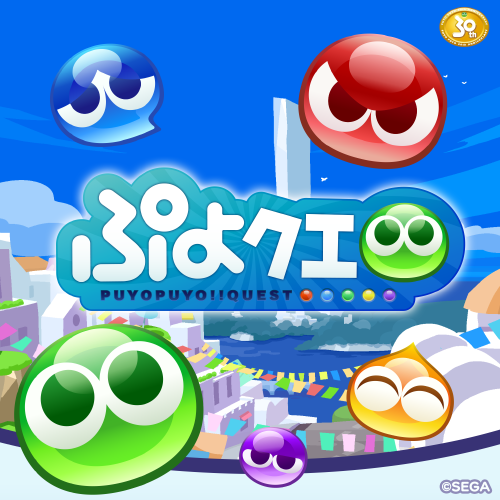
Source of image: https://puyo.sega.jp/portal/index.html
* The way the pink object falls from the top of the screen to the bottom of the screen and then disappears is referencing the gameplay of games in the "Puyo Puyo" series. Puyo's fall from the top of the screen to the bottom of the screen and then disappear when they are placed such that 4 or more of the same colored Puyo are directly next to each other.
* On a related note, Arle Nadja, the "Bayoe~n" spell, and Puyo all originally come from "Madou Monogatari" (魔導物語), "Sorcery Story", a video game series released by Compile (コンパイル) from 1989 to 1998.S2
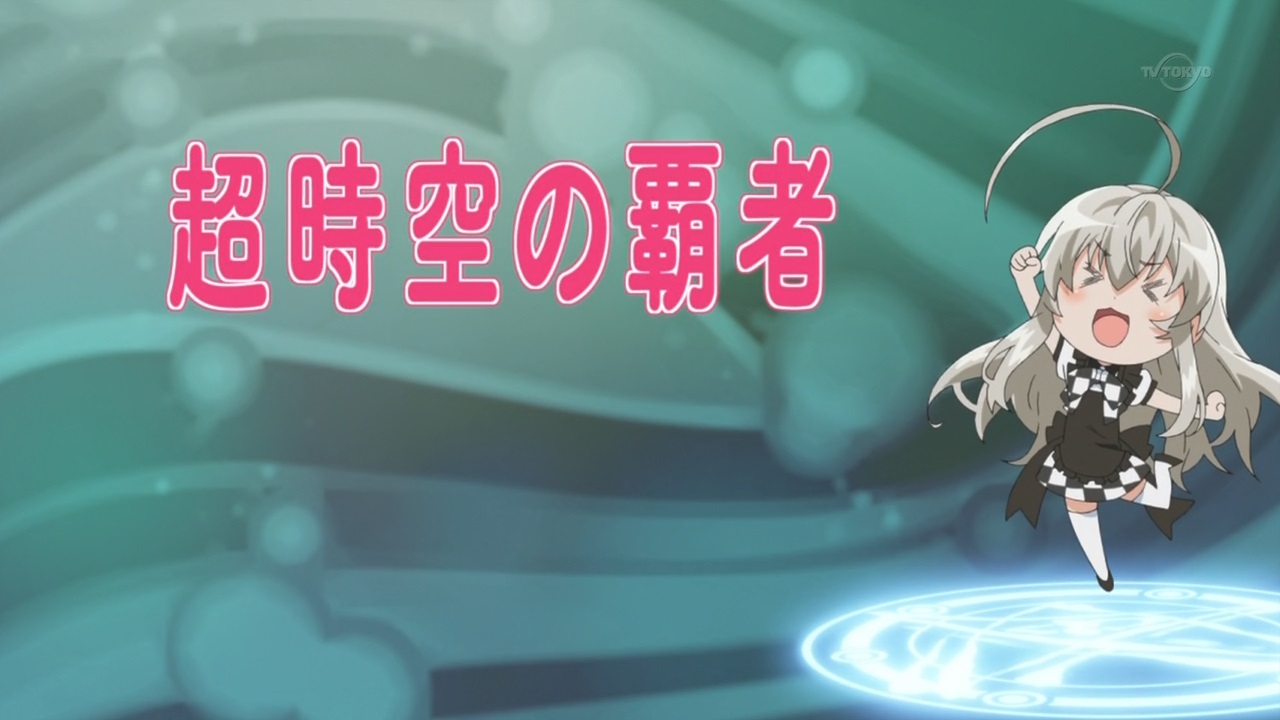
(3:48)
The title of this episode is "Chou Jikuu no Hasha" (超時空の覇者), which translates to "The Ruler of Super Time and Space". This is referencing "Jikuu no Hasha ~ Sa·Ga 3 [Kanketsu Hen]" (時空の覇者 Sa・Ga3 [完結編]), "The Ruler of Time and Space ~ SaGa 3 [Final Chapter]", a video game released by Square (スクウェア) in 1991. On a related note, this game contains creatures that are based on creatures from the Cthulhu Mythos.S4
"I'm not playing any dirty games." (4:24)
The Japanese line is "Pinku no shiori wo purei suru tsumori ha nai kara" (ピンクのしおりをプレイするつもりはないから). This more literally translates to "I have no intention of playing the pink bookmark". "Pinku no Shiori" (ピンクのしおり), "Pink Bookmark", is referencing the game "Kamaitachi no Yoru" (かまいたちの夜), "Night of the Sickle Weasel", released by Chunsoft in 1994. The game is a sound novel, the origin of novel-type games, wherein the player reads the story, makes decisions when prompted, and attempts to reach the ending. There are several endings to this game, ranging from good to bad. There are also save states, displayed as bookmarks, that allow one to save one's progress. If one reads through every ending, then the bookmark containing the save data will change color to pink and two extra scenarios are unlocked. This concept of the save data turning pink and extra scenarios being unlocked after certain requirements are cleared is also present in sequels of the game. In particular, in "Kamaitachi no Yoru Tsuu Kangokujima no Warabe Uta" (かまいたちの夜2 監獄島のわらべ唄), "Night of the Sickle Weasel 2: Folk Song of the Island Prison", released in 2002, one of the scenarios unlocked is a bit risque in nature. Because of this and the indicator that the scenario has be unlocked, the scenario was nicknamed "Pinku no Shiori" (ピンクのしおり), "Pink Bookmark".S1 Image of the pink bookmark save state in the first Kamaitachi no Yoru:

Source of image: http://game3.okoshi-yasu.com/dougaSome/Tas/tas24.html
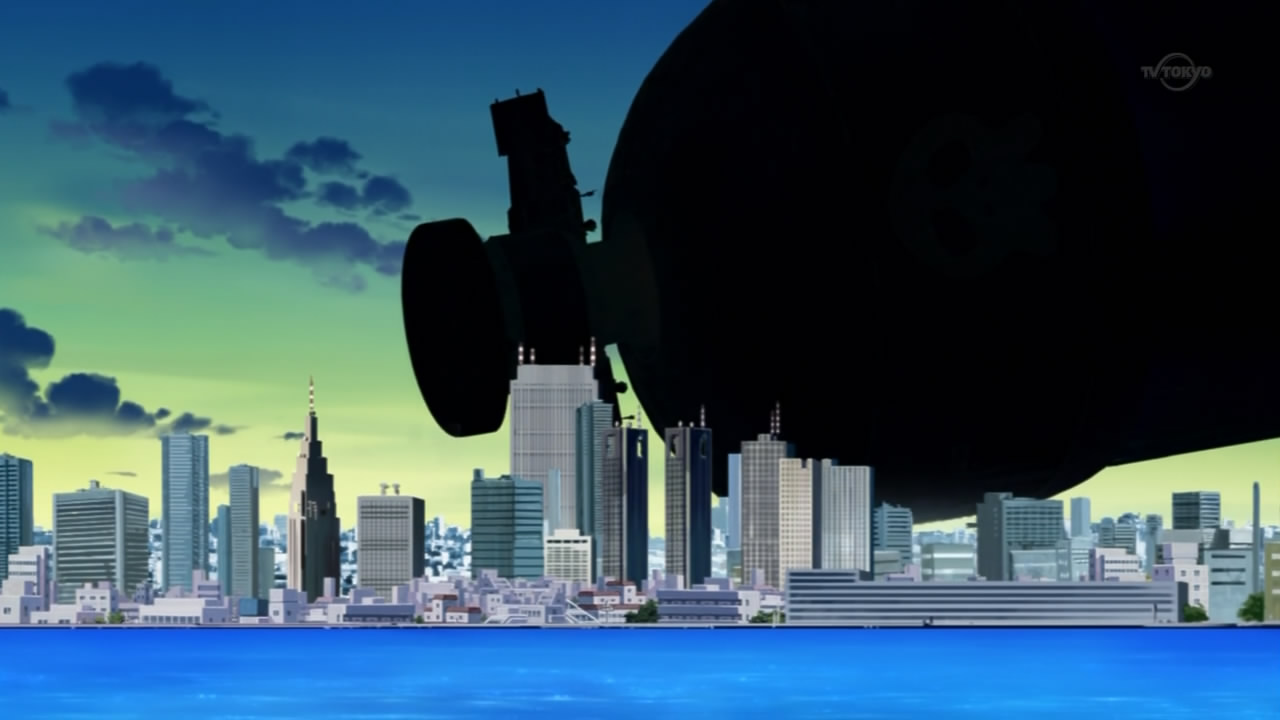
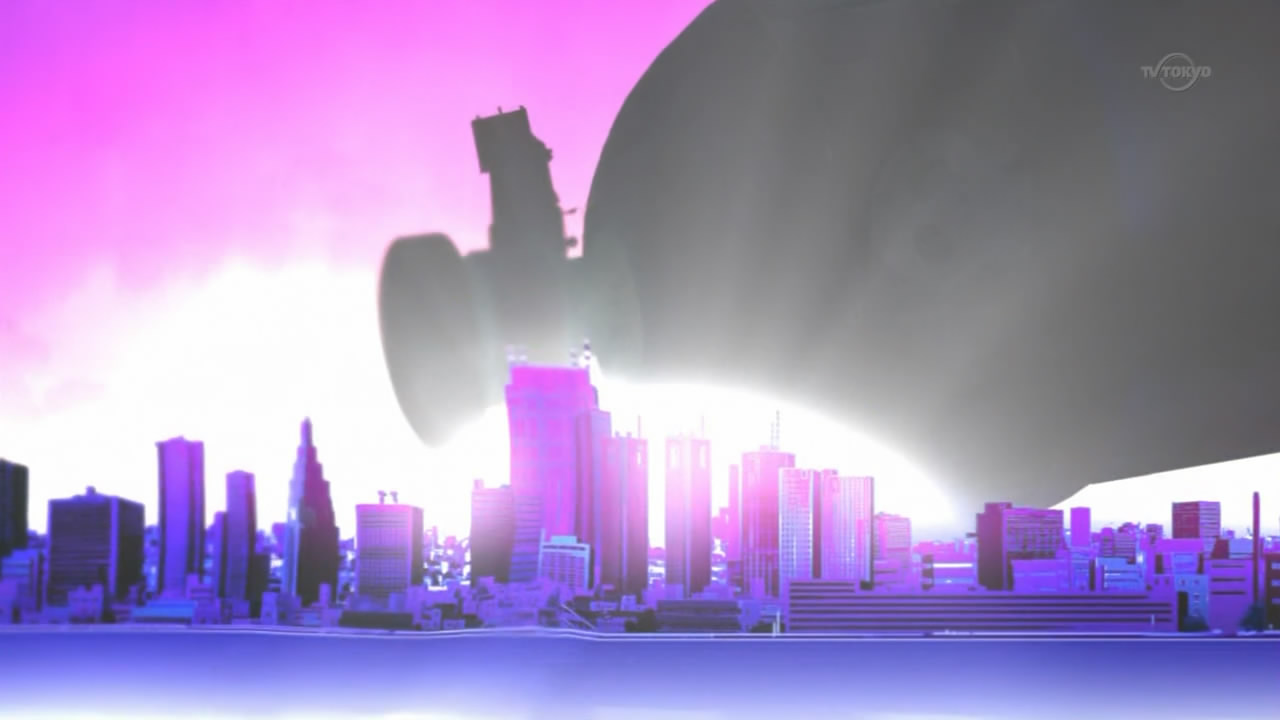
(4:43)
The scene depicted is referencing "koronii otoshi" (コロニー落とし), "colony drop", an event in which a space colony was dropped onto Earth causing widespread damage. This event was shown in prologue of the first episode of "Mobile Suit Gundam" (機動戦士ガンダム), an anime series that aired from 1979 to 1980.S1 Images for reference:
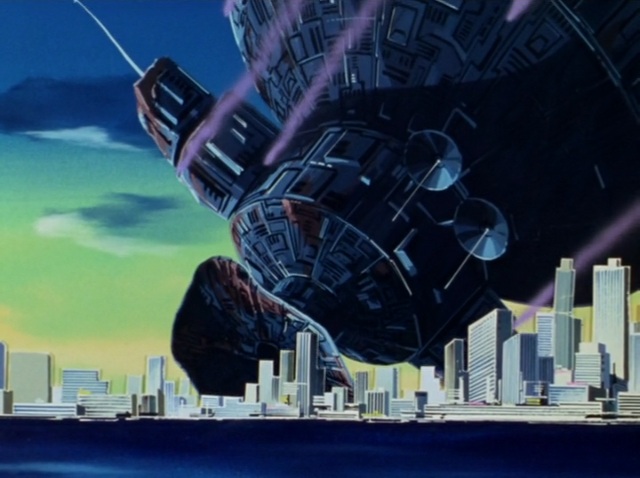
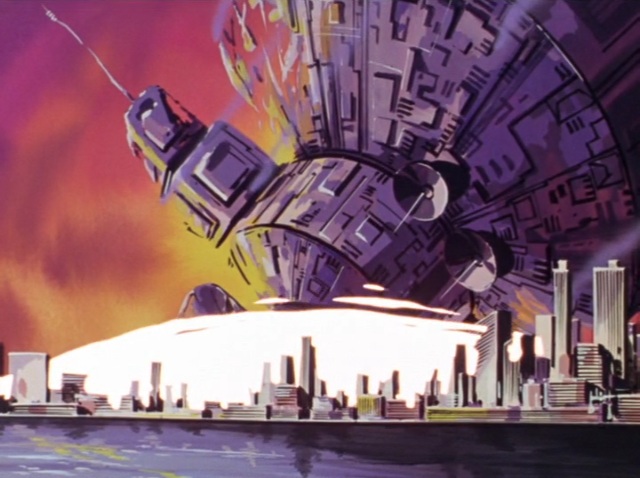
"As long as I'm around, whether they try to drop a colony or an asteroid on us, I'll blast them away, so don't worry!"(5:03)
The phrase "drop a colony" (コロニーが落とされよう koronii ga otosareyou) is referencing the aforementioned "colony drop" from the anime series "Mobile Suit Gundam" (機動戦士ガンダム). The phrase "drop an asteroid" (小惑星が落とされよう shouwakusei ga otosareyou) is referencing Char Aznable (シャア・アズナブル) who tried to drop the asteroid base Axis (アクシズ) onto Earth in "Mobile Suit Gundam: Char's Counterattack" (機動戦士ガンダム 逆襲のシャア), a movie released in 1988.S2
"If you walk clockwise with your left hand against the wall, you will not fall into pit traps. However, this only works in the original version prior to the remake." (6:09)
Cthuko's navigation strategy is referencing "Dragon Quest II: Luminaries of the Legendary Line" (ドラゴンクエストII 悪霊の神々), a video game released in 1987. This is the same strategy that can be applied to safely traverse the Cave to Rhone (ロンダルキアへの洞窟), the final dungeon before the last boss.S1 Specifically this strategy is used on floor 5 of the dungeon, which has many pitfall traps. There are no hints given in the game on how to traverse this floor, so it is very difficult to clear. Like Cthuko says, this strategy only works on the original "Dragon Quest II" on the NES. In the SNES remake the positions of the pitfalls have changed.S3
"My name is Isurugi." (7:11)
This character's name is "Isurugi" (イス動). There are two references here:
* This is referencing "iisu" (イース), "Yith", the name of the planet from which this character's species originates.
* This is referencing Isurugi Gisaku (石動戯作) from "Kuroi Hotoke" (黒い仏), "Black Buddha", a Japanese Cthulhu Mythos novel written by Shunou Masayuki (殊能将之) and published in 2001.S1
"Creators who bring excitement to video sharing sites, popular artists within illustration communities, all will be ours!" (7:37)
This is likely referencing the Japanese video sharing website Nico Nico Douga and the Japanese illustration community pixiv.S2
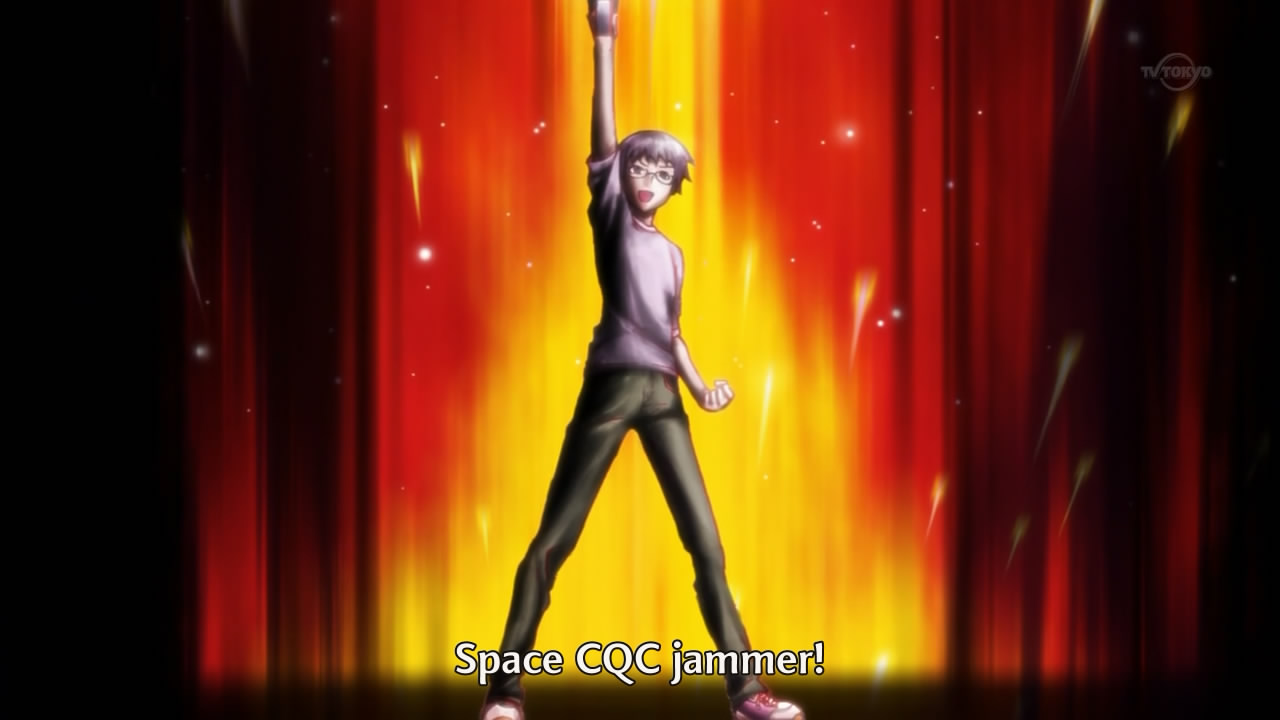
"Space CQC jammer!" (8:15)
There are two references here:
* This is referencing the Neutron Jammer (ニュートロンジャマー) from "Mobile Suit Gundam SEED" (機動戦士ガンダムSEED), an anime series that aired from 2002 to 2003. In the series, it is a device that suppresses nuclear fission reactions and prevents the use of nuclear weapons and reactors.
* Isurugi's pose, which he and Yithka also make at 8:46 and 8:54, is referencing the "Last Shooting" (ラストシューティング) scene from episode 43 of "Mobile Suit Gundam" (機動戦士ガンダム), in which the RX-78-2 Gundam fires one last shot to destroy the MSN-02 Zeong during the battle of A Baoa Qu.S1 Video for reference: https://youtu.be/ZsPnwBQrfRM?t=3m44s In particular, the drawing style of the scene is referencing a picture of the "Lasting Shooting" drawn by Okawara Kunio (大河原邦男), a mechanical designer who worked on "Mobile Suit Gundam".S2 Image for reference:
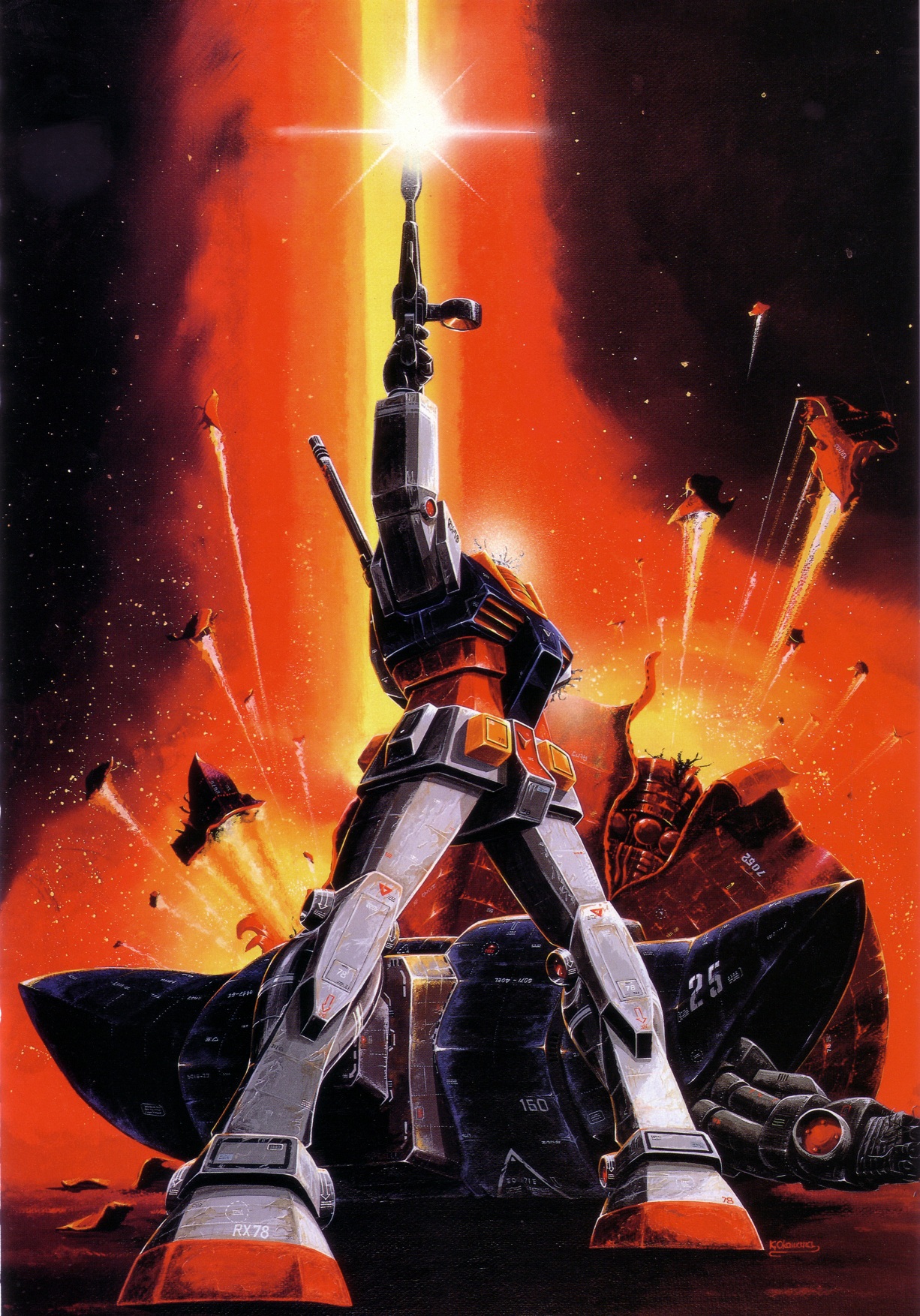
"He blocked our Space CQC." (8:21)
The Japanese line is "Uchuu CQC ga jama sareta" (宇宙CQCが邪魔された). This literally means "Space CQC was interfered with", using the term "jama" (邪魔), which means "interference" or "hindrance". This is a pun on "jamaa" (ジャマー) the Japanese pronunciation of "jammer".S1
(8:30)
The line at this time goes as follows:
「こんなこともあろうかと宇宙CQCジャマーキャンセラーを用意しておいたですョ!」There are two references here:
"Konna koto mo arou ka to uchuu CQC jamaa kyanseraa wo youi shite oita desu yo!"
"I thought this might happen. That's why I prepared a Space CQC jammer canceler!"
* This is referencing a line said by Sanada Shirou, the chief engineer aboard Space Battleship Yamato, in episode 10 of "Uchuu Senkan Yamato 2" (宇宙戦艦ヤマト2), "Space Battleship Yamato 2", an anime series that aired from 1978 to 1979.S2 Sanada's line goes as follows:
「たぶんこんなこともあろうと思って、アステロイドリングにエネルギーの吸収装置をセットしておいた」* This is referencing the Neutron Jammer Canceler (ニュートロンジャマーキャンセラー) from "Mobile Suit Gundam SEED" (機動戦士ガンダムSEED). In the series, it is a device that negates the effects of the aforementioned Neutron Jammer. The following Space CQC jammer canceler breaker and such are not based on anything, but simply continue the pattern of disabling and negating the disabling.
"Tabun konna koto mo arou to omotte, asuteroido ringu ni enerugii no kyuushuu souchi wo setto shite oita"
"I thought this might happen, so I set up an energy absorption device in the asteroid ring beforehand."
"I have prepared something for that!" (8:44)
The Japanese line is "Touhou ni geigeki no you ni ari" (当方に迎撃の用意あり). This is referencing the same line said by Hagakure Kakugo (葉隠覚悟) in chapter 2 of volume 1 of "Kakugo no Susume" (覚悟のススメ), "Encouragement of Resolve", a manga series written by Yamaguchi Takayuki (山口貴由) and published from 1994 to 1996.S1 Image for reference:
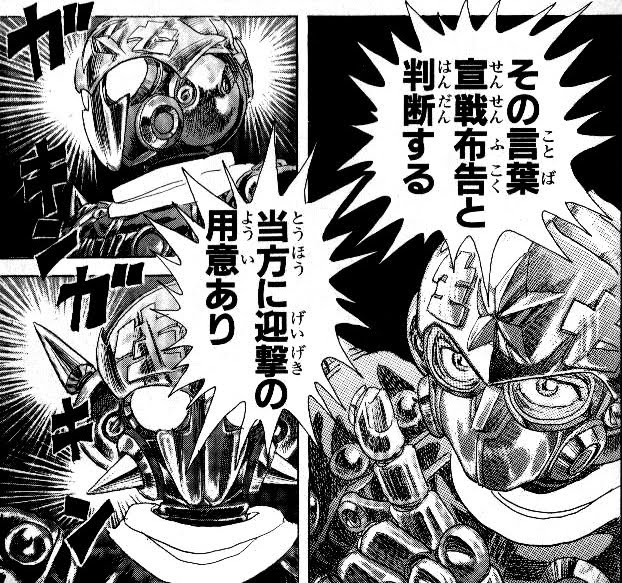
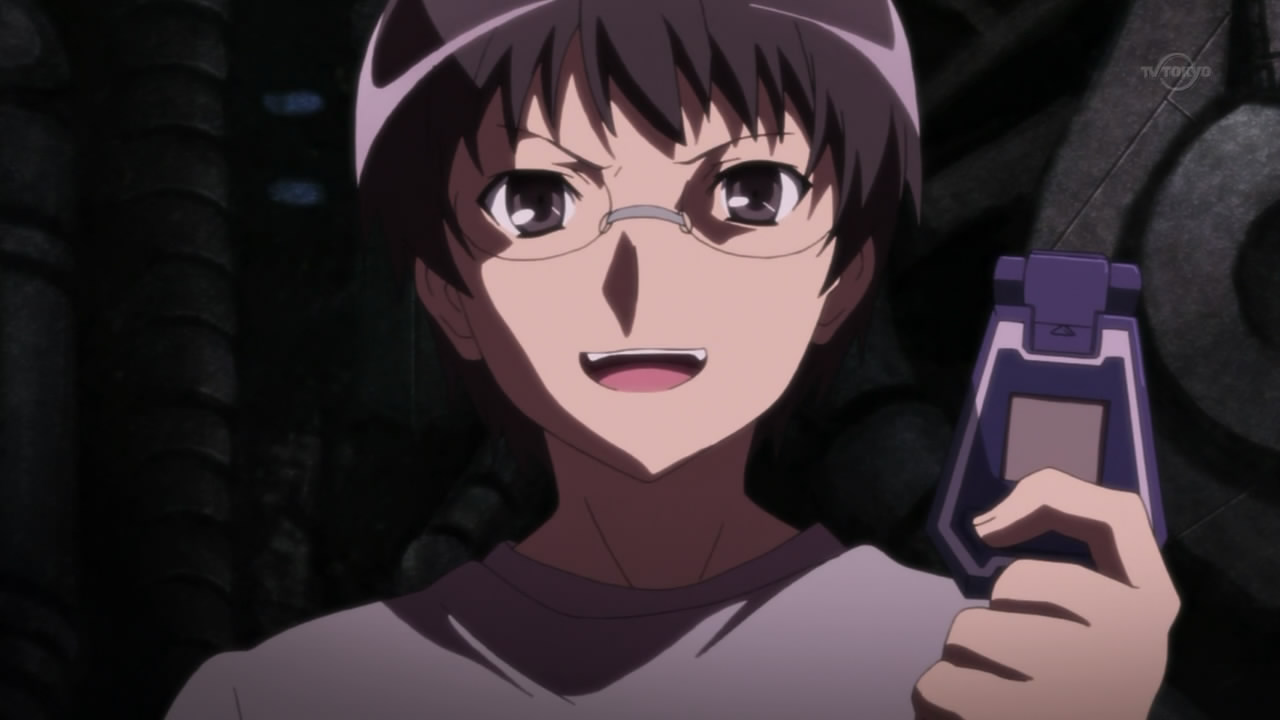
(9:33)
The device that Isurugi holds up is referencing the AGE Device from "Mobile Suit Gundam AGE" (機動戦士ガンダムAGE), an anime series that aired from 2011 to 2012. The AGE Device acts as a key to activate the AGE System that controls Gundam AGE.S1 Image for reference:
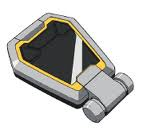
Source of image: http://gundam.wikia.com/wiki/AGE_Device
* On a related note, the person who voices Yoichi, Hatano Wataru (羽多野渉), also voices Largan Drace in "Mobile Suit Gundam AGE".S3
* On another related note, the person who wrote the script for episode 10 of "Haiyore! Nyaruko-san", Hyoudou Kazuho (兵頭一歩), also wrote the script for many episodes of "Mobile Suit Gundam AGE".S2
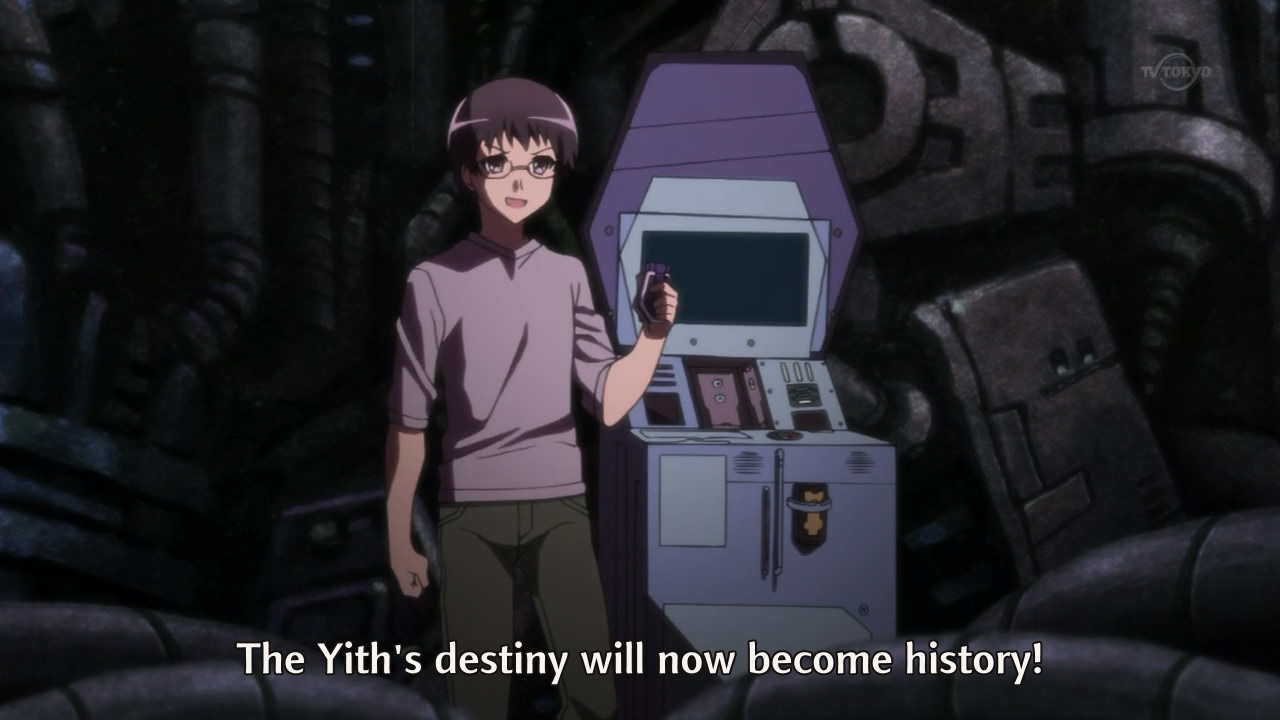
"The Yith's destiny will now become history!" (9:38)
There are two references here:
* The Japanese line is "Ima koso Iisu no unmei wo rekishi ni naru" (今こそイースの運命を歴史になる). This is referencing the catch phrase used in the next episode previews for "Mobile Suit Gundam AGE". The line goes "Mitsu no unmei ga rekishi ni naru" (三つの運命が歴史になる), which translates to "Three destinies will become history".S1
* The device behind Isurugi is referencing the video game arcade cabinet for "Gage-ing Battle Base" (ゲイジングバトルベース Geijingu Batoru Beesu), a game based on "Mobile Suit Gundam AGE".S1 The game can scan compatible Gundam models and figures, an action called "Gage-ing", which allows one to play a battle simulation game featuring that suit. Image for reference:
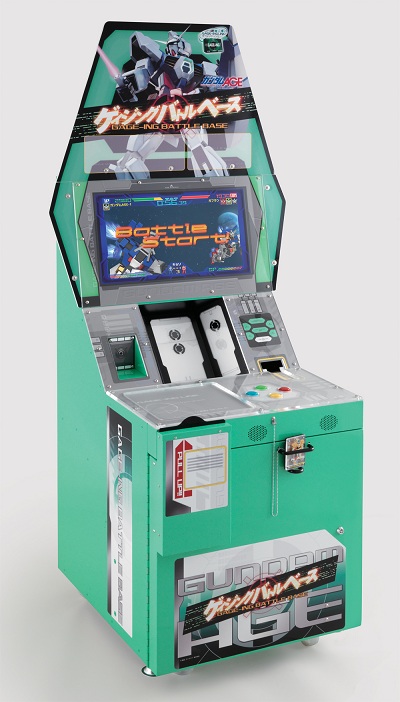
Source of image: http://tom10.exblog.jp/14696374/
In addition, there is a handheld toy AGE Device that contains 7 pilot simulation games. By playing the games a player can accumulate experience points and level up. The toy AGE Device can be inserted into the "Gage-ing Battle Base" to upload data for use in the game. Like in the anime, one needs to use the toy AGE Device to "activate" the "Gage-ing Battle Base" and start the game. Video demonstration of the "Gage-ing Battle Base" and its related goods: https://youtube.com/watch?v=MfaGMtfv9Mo
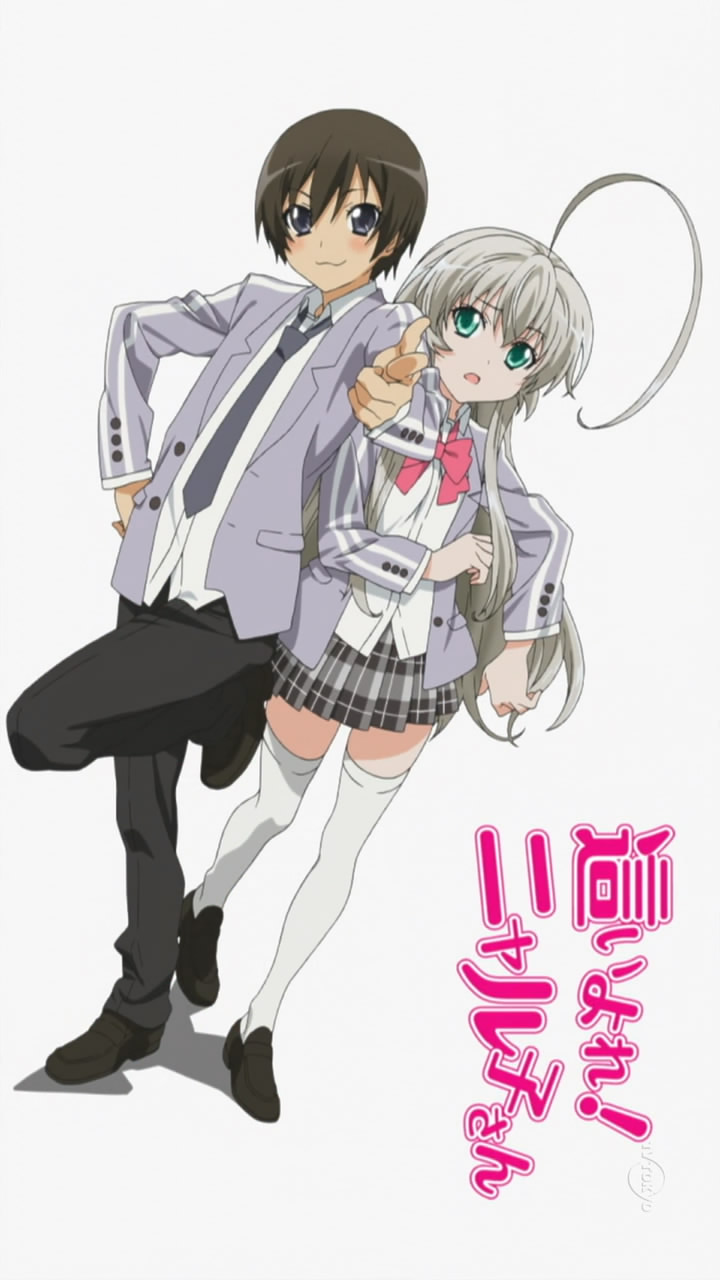
(9:58)
This image is based on promotional artwork used for "Haiyore! Nyaruko-san". Image for reference:

Source of image: http://nyaruko.com/
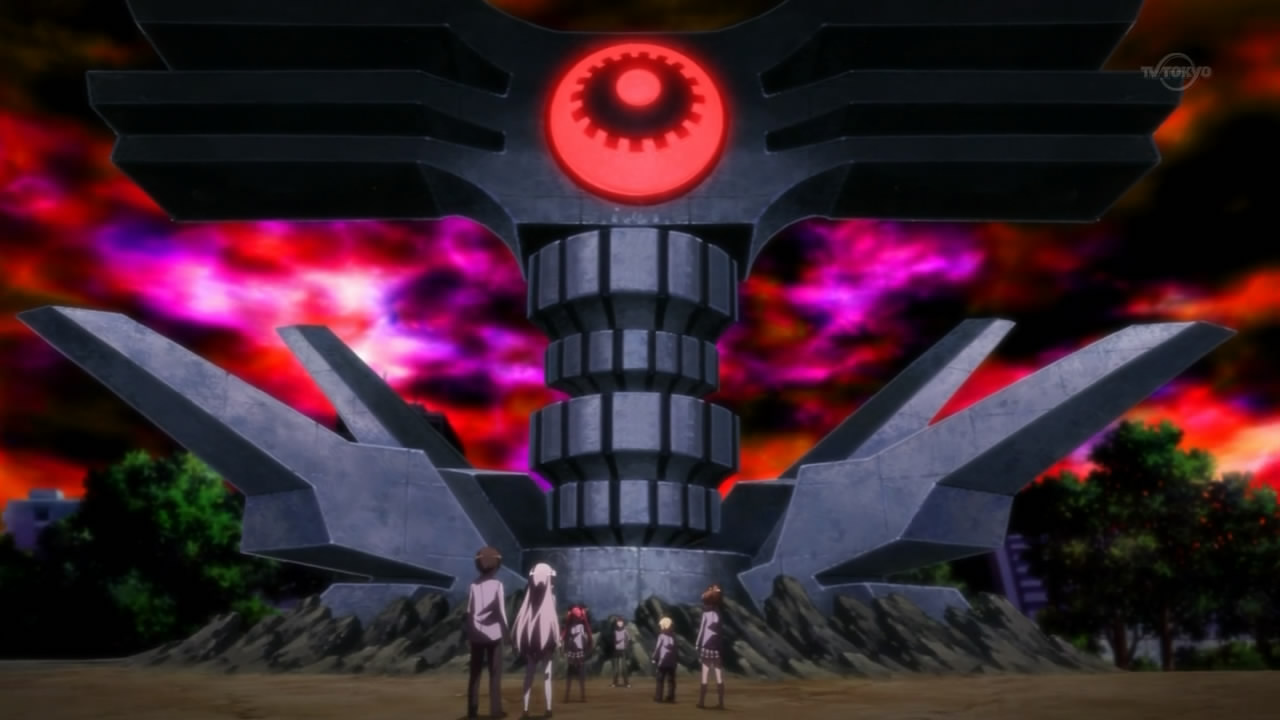
(10:05)
The "Earthling annihilation device" (地球人類抹殺装置 chikyuu jinrui massatsu souchi) bears great resemblance to the "Monument to the Revolution of the people of Moslavina", a World War II memorial sculpture by Dušan Džamonja, located in Podgarić, Berek, Croatia.S1 Image for reference:
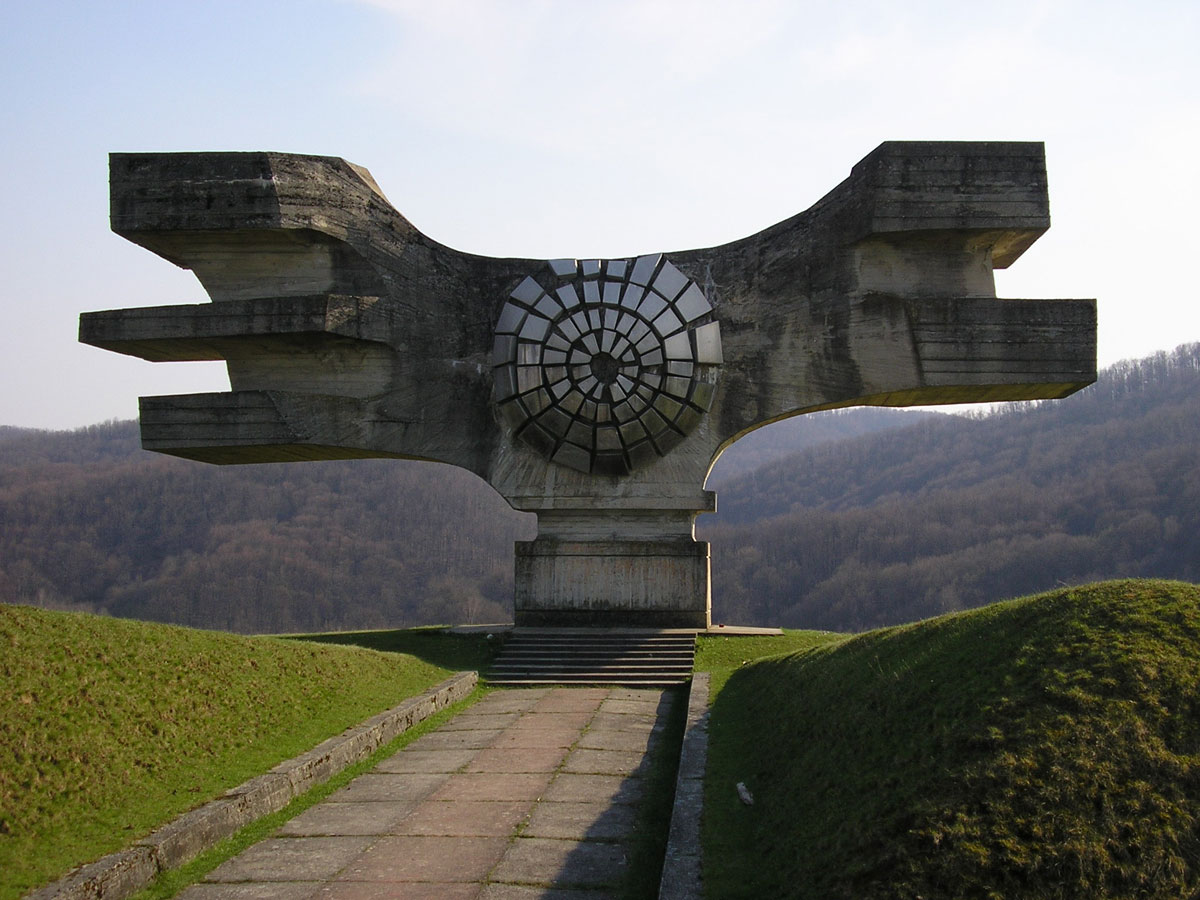
Source of image: http://www.artificialowl.net/2008/10/abandoned-monument-by-sculptor-duan.html
"Comrades! Wouldn't it be a fine time to inkvade?" (10:15)
The Japanese line is "Nakama-tachi yo, shinryaku shiyou ja na ika" (仲間たちよ、侵略しようじゃないか). This is referencing the manga "Shinryaku! Ika Musume" (侵略!イカ娘), "Invade! Squid Girl", and the speech patterns of the title character from that series, Ika Musume.
* In the series, Ika Musume attempts to invade human civilization as punishment for the pollution done to the sea, though to little success.
* Being a squid girl, she makes squid oriented references when speaking, such as ending her sentences with the phrase "de geso", instead of the usual "desu", where "geso" literally means "squid tentacle". Yoichi's line in particular ends with "ja na ika" with the "ika" emphasized. This is another common speaking habit of Ika Musume. The phrase "ja nai ka" in Japanese roughly means "isn't it?", however Ika Musume emphasizes the "ika", which means "squid" in Japanese.
"Great Lea... I mean, Mr. President!" (10:38)
There are two references here:
* The Japanese line is "Daishu... A, iya... Daisoutou-sama!" (大しゅ・・・あ、いや・・・大総統様!). What Isurugi was about to say before he corrects himself is "Daishuryou-sama" (大首領様), which translates to "Great Leader". This is what Isurugi calls his leader in chapter 4 of volume 3 of the "Haiyore! Nyaruko-san" light novel series.S3 This is referencing "Shokkaa Shuryou" (ショッカー首領), "Leader of Shocker", from "Kamen Rider" (仮面ライダー), a Japanese TV show about a masked super hero that aired from 1971 to 1973.S5
* The leader's name in this episode is "Daisoutou-sama" (大総統様), which translates to "Great President". This appears to be referencing his voice actor, Iizuka Shoko (飯塚昭三), who has voiced various villains that have high leadership positions. One such role of his is "Heru Sataan Soutou" (ヘルサターン総統), "President Hell Saturn", from "Taiyou Sentai San Barukan" (太陽戦隊サンバルカン), "Solar Squadron Sun Vulcan", a Japanese live-action TV show that aired from 1981 to 1982.S2
(13:01)
The line at this time goes as follows:
「宇宙人には負けると分かっていても戦わなければならない時がある」This is referencing a famous quote by Fukuzawa Yukichi (福澤諭吉), a Japanese writer, enlightenment thinker, and teacher.S1 The original quote goes as follows:
"Uchuujin ni ha makeru to wakatteite mo tatakawanakereba naranai toki ga aru"
"Sometimes an alien must fight, even if she knows she will lose."
「人間は、負けるとわかっていても、戦わねばならない時がある」
"Ningen ha, makeru to wakatteite mo, tatakawanuba naranai toki ga aru"
"There are times when a person must fight, even if he knows he will lose."
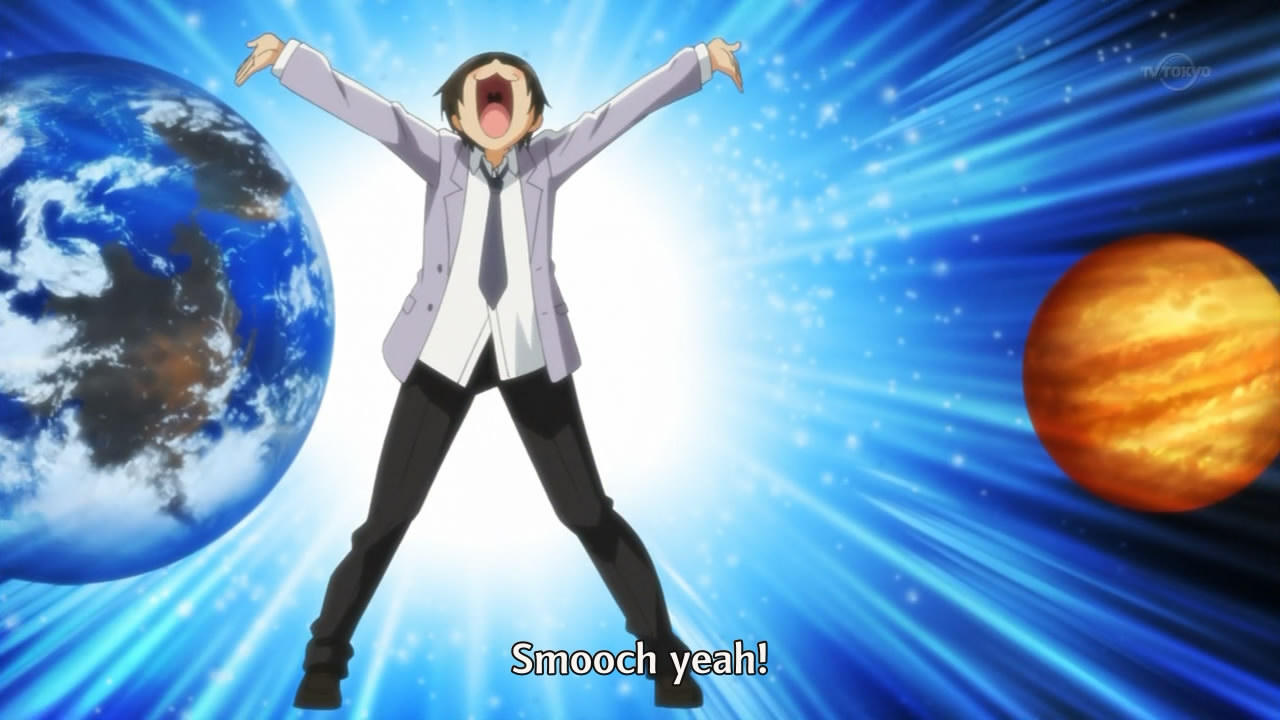
"I got a kiss!" (16:03)
The Japanese line is "Buchuu, kitaa!" (ブチュウ、きたー!). This is referencing the catch phrase of Kamen Rider Fourze from "Kamen Rider Fourze" (仮面ライダーフォーゼ), a Japanese TV show about a masked super hero that aired from 2011 to 2012. Fourze's line is "Uchuu kitaa!" (宇宙キター!), which he says after transforming. The word "kita" (キタ) literally means "it came!", or more loosely "it's here!", but it is typically used to express excitement at something that happened or appeared. The phrase as a whole means something like "Space is awesome!". The pose that Nyaruko is making is also referencing the pose Fourze makes when he says this line. Image for reference:
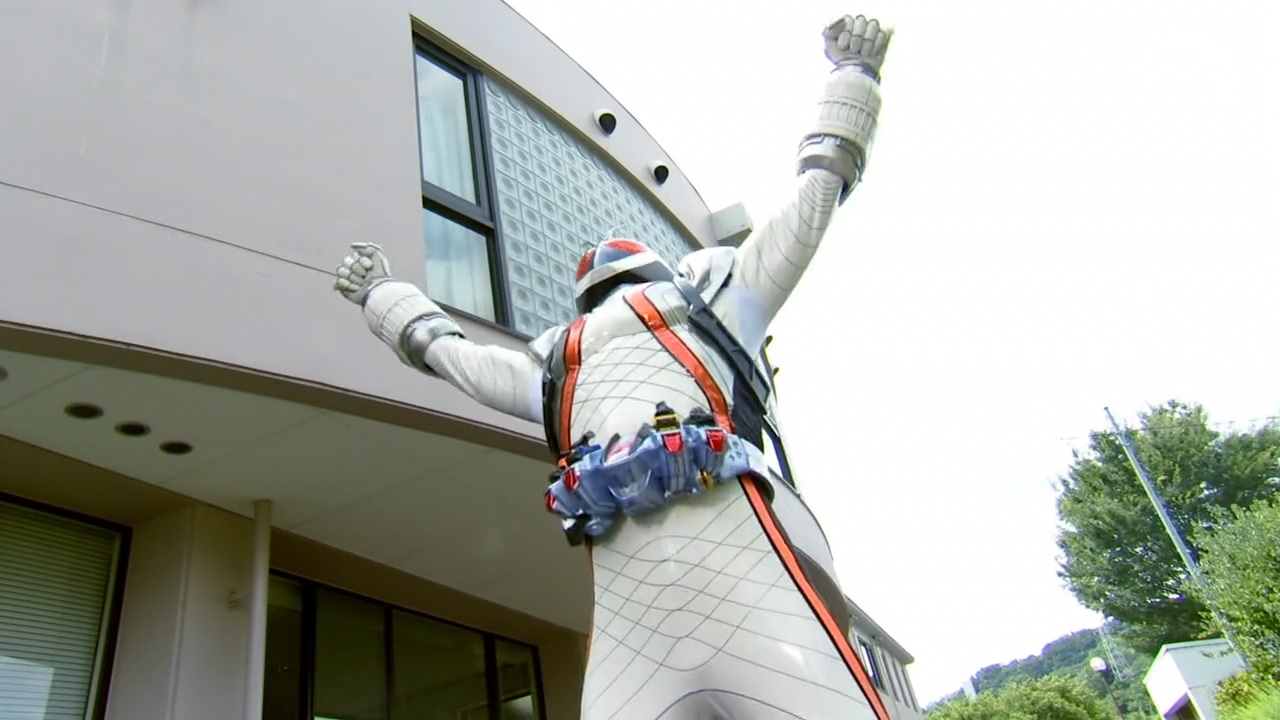

(16:13)
The zoom out to the Earth is also referencing "Kamen Rider Fourze" (仮面ライダーフォーゼ). Occasionally when Fourze says his "Uchuu Kitaa!" catch phrase the screen will zoom out to the Earth or even farther out into space. This happens in episode 5, for example. Image for reference:
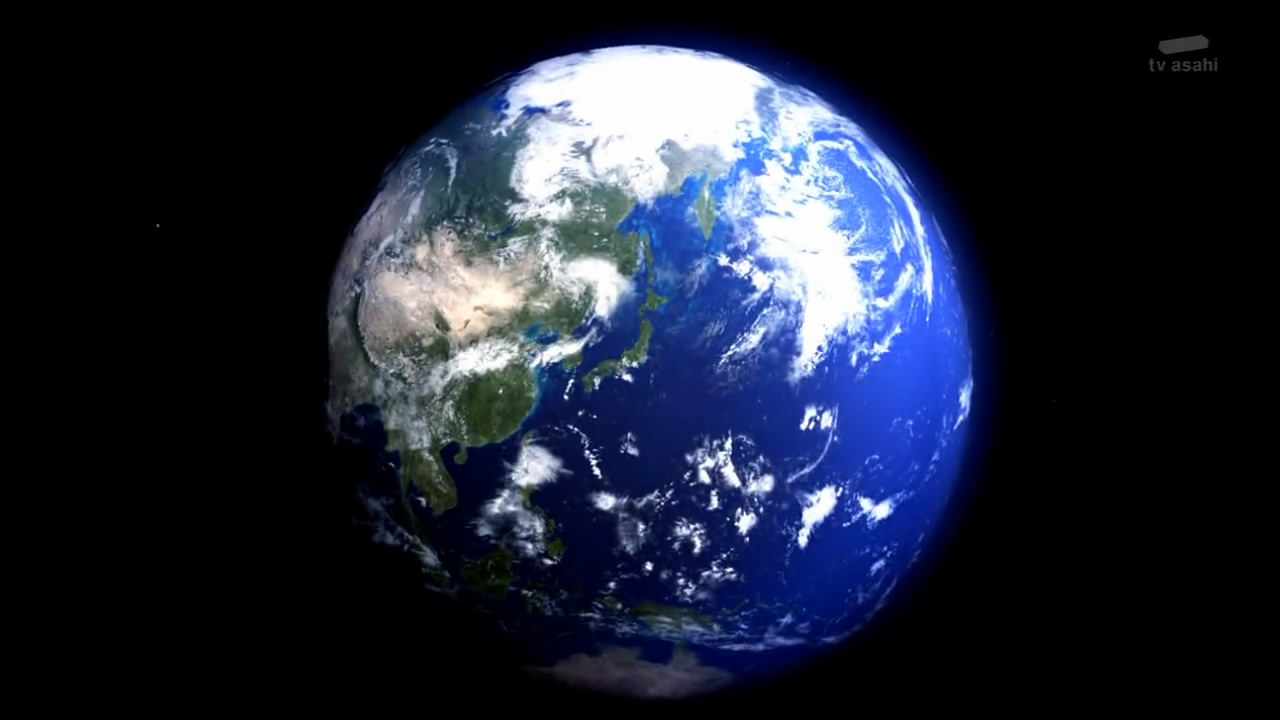

(16:25)
This is the crystal Nyaruko gave Mahiro in episode 2. It is based on the Shining Trapezohedron, a mystical crystal that serves as a window on all of space and time and first appeared in "The Haunter of the Dark", a story written by H. P. Lovecraft and first published in 1936. Like its original it is a "crazily angled stone", rather than a true Trapezohedron.
"I ended up giving you a cruel angel's kiss." (16:42)
The Japanese line is "Tsuitsui zankoku na tenshi no beeze wo shite shimatta no desu" (ついつい残酷な天使のベーゼをしてしまったのです). This is referencing "Zankoku na Tenshi no Teeze" (残酷な天使のテーゼ), "A Cruel Angel's Thesis", a song sung by Takahashi Youko (高橋 洋子) and released in 1995. This song is the opening theme song to "Shinseiki Evangerion" (新世紀エヴァンゲリオン), "Neon Genesis Evangelion", an anime series that aired from 1995 to 1996.
"Thanks for waiting!" (17:03)
The Japanese line is "Omataseman desu yo!" (オマタセマンですョ!). There are two references here:
* "Omatase" (お待たせ) more literally translates to "I have made you wait", but is generally used to mean "thank you for waiting".
* This is referencing "Omataseman no Uta" (オマタセマンの歌), roughly "Song about the man who keeps you waiting", a song sung by Yamamoto Masayuki (山本正之) and released in 1988.S2
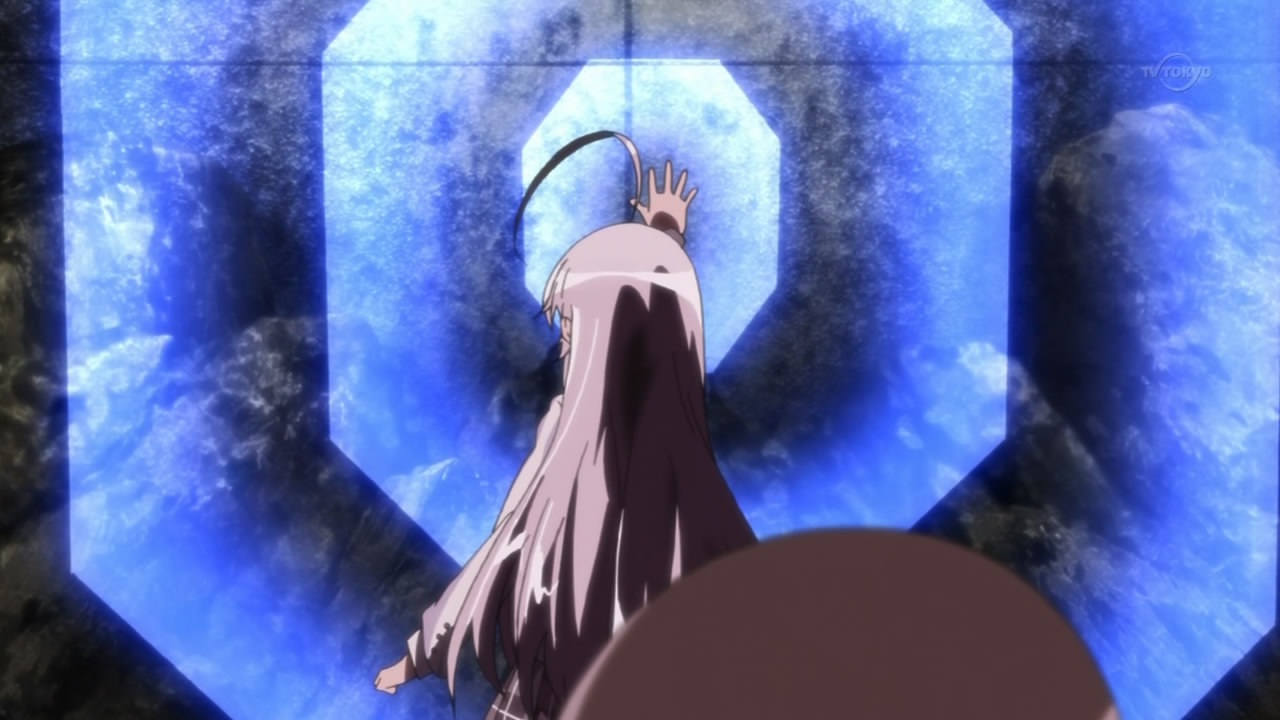
(17:25)
The barrier that Nyaruko projects in this scene resembles "AT Field" (ATフィールド), "Absolute Terror Field", a powerful barrier from the anime series "Neon Genesis Evangelion" (新世紀エヴァンゲリオン).S1 Image for reference:
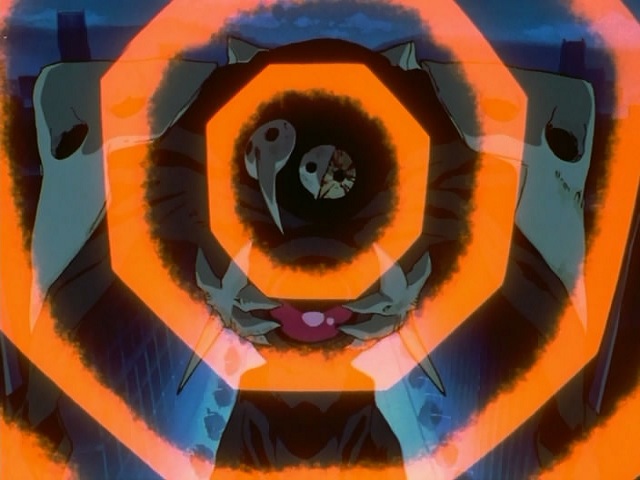
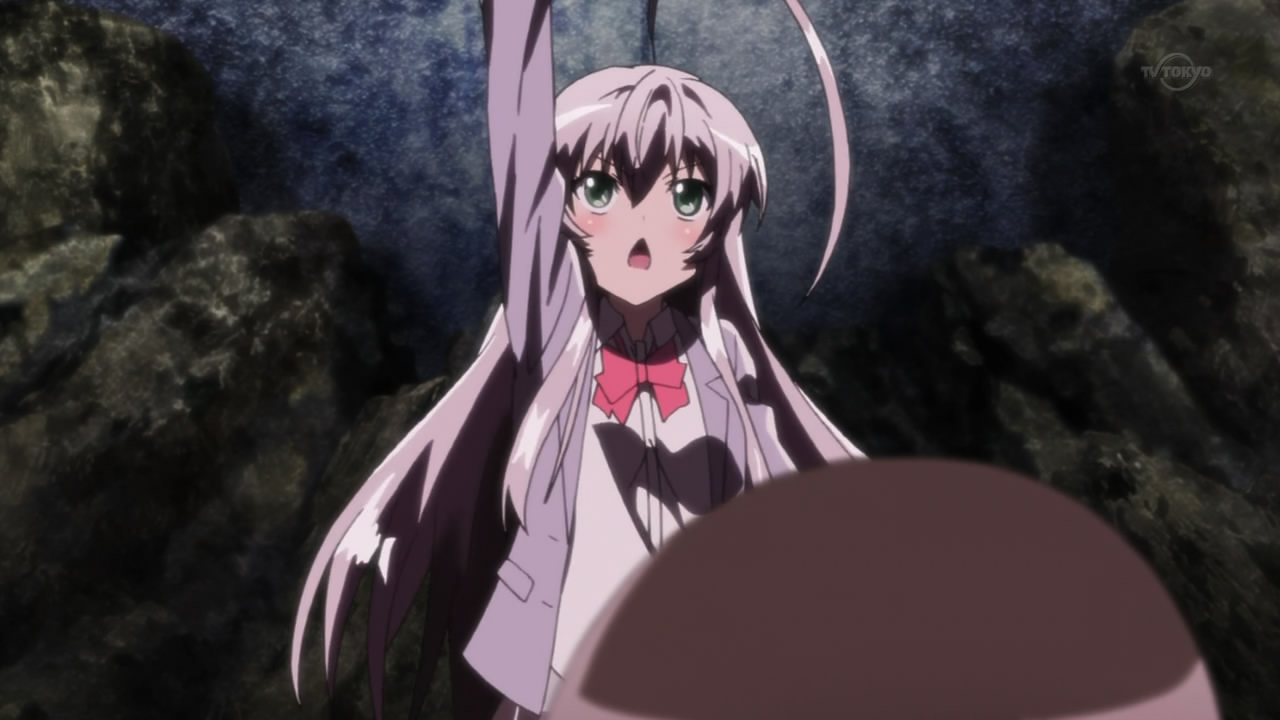
(17:31)
Like in episode 5 at 15:03, Nyaruko's poses are referencing those of Kamen Rider Fourze from "Kamen Rider Fourze" (仮面ライダーフォーゼ). However, the sequence Nyaruko does her poses in is the reverse order of Fourze's poses. The last pose of her pulling a lever is referencing how Fourze pulls a lever on his belt to activate the transformation.S3 Images for reference:

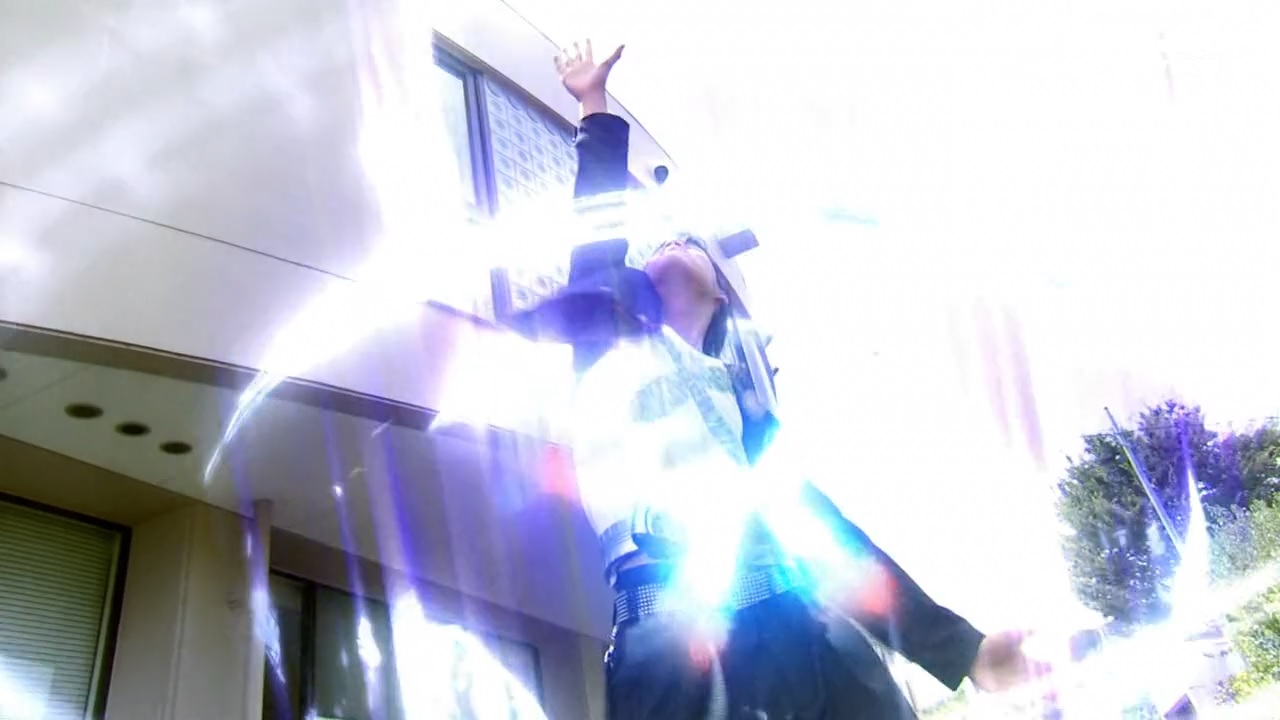
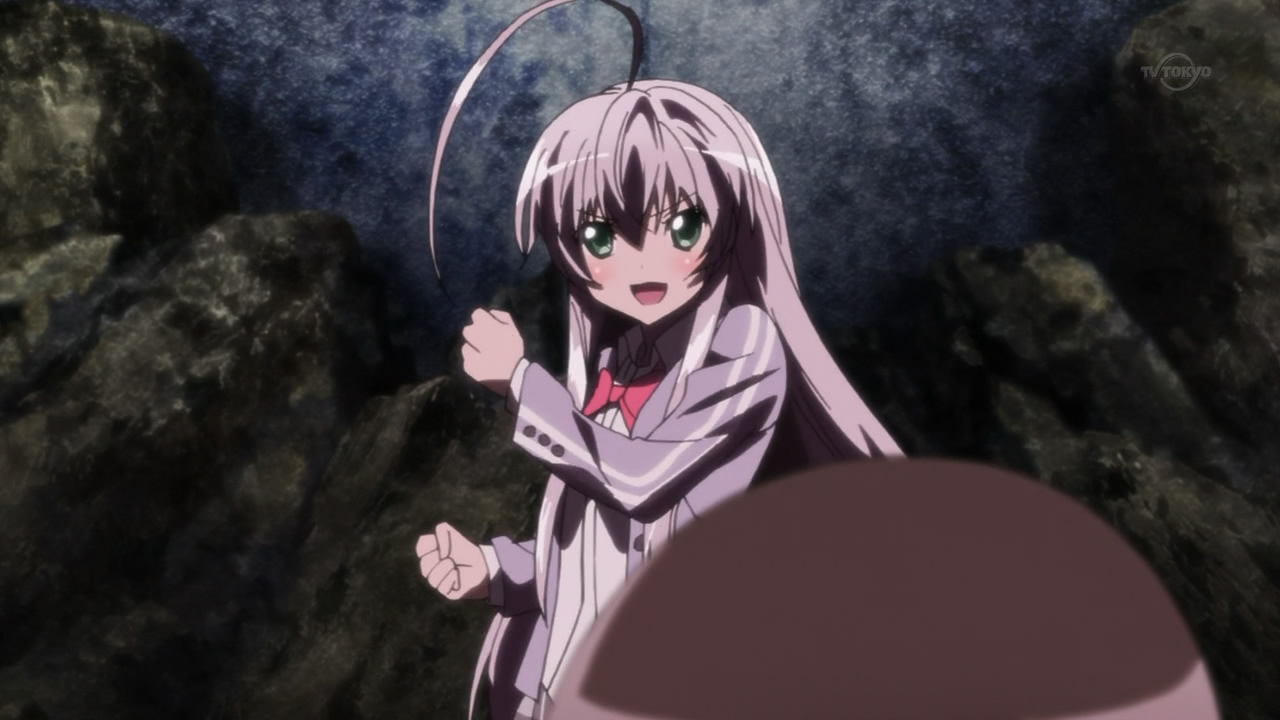
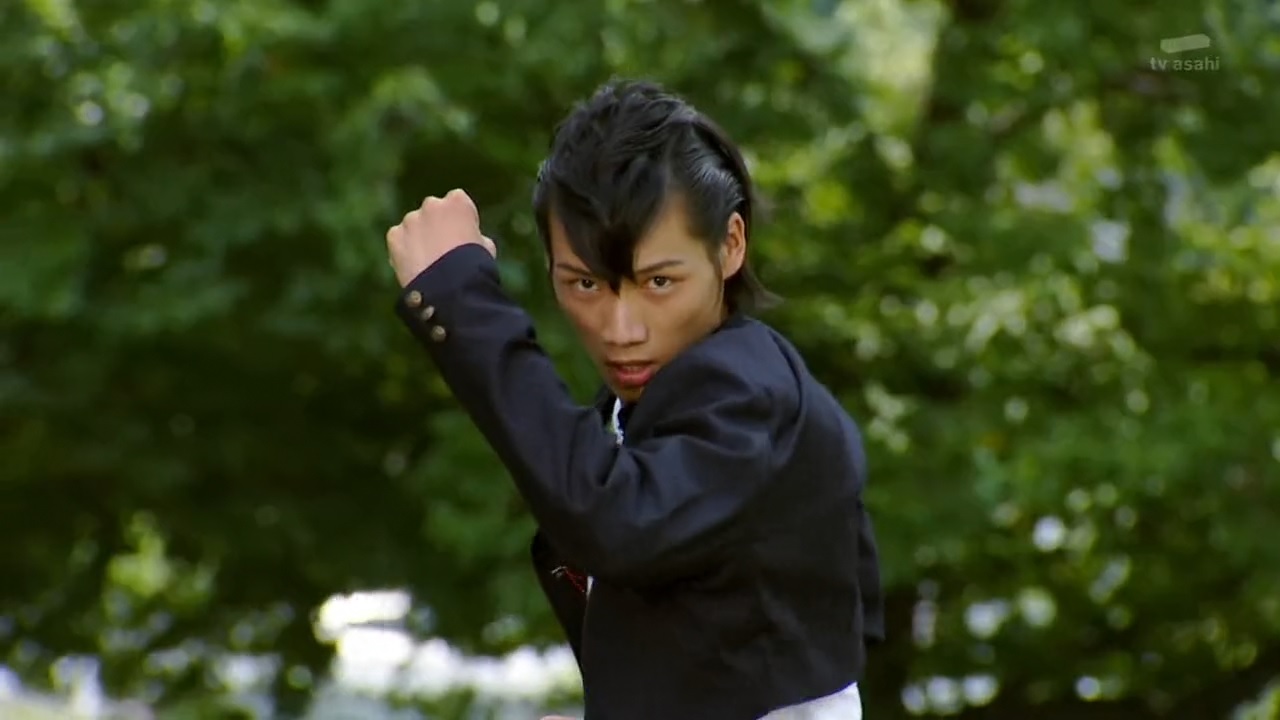
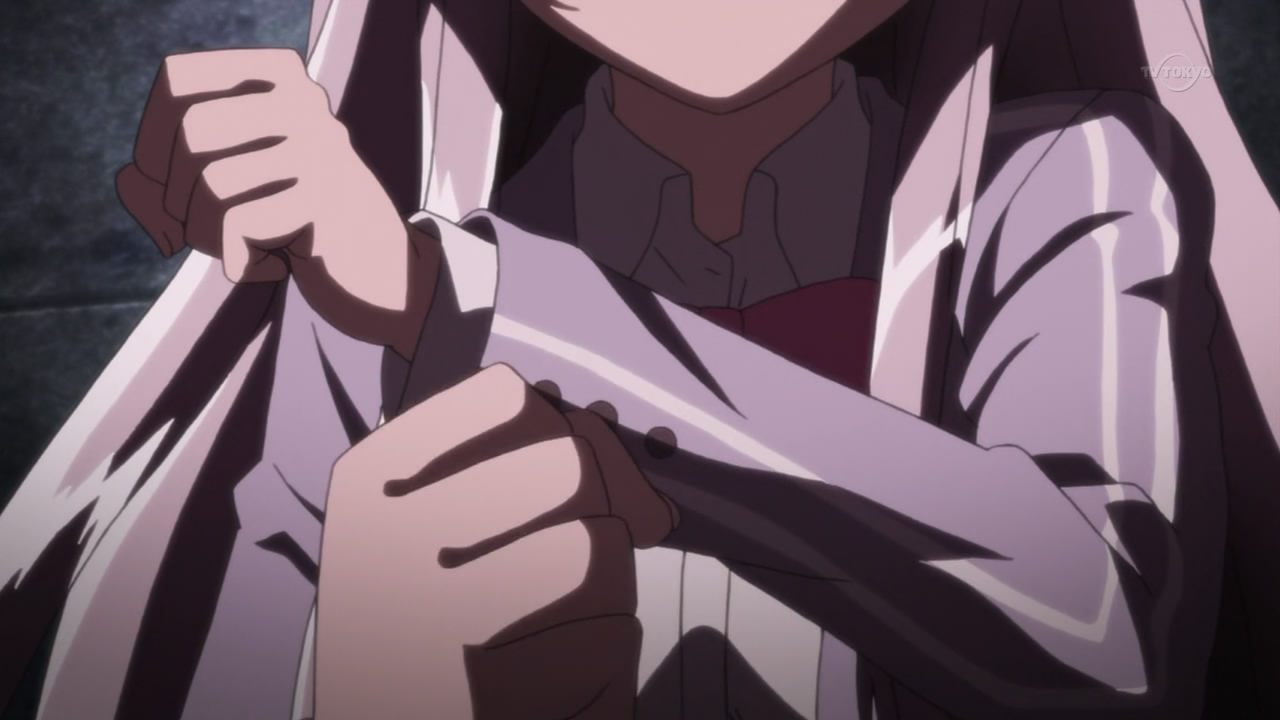
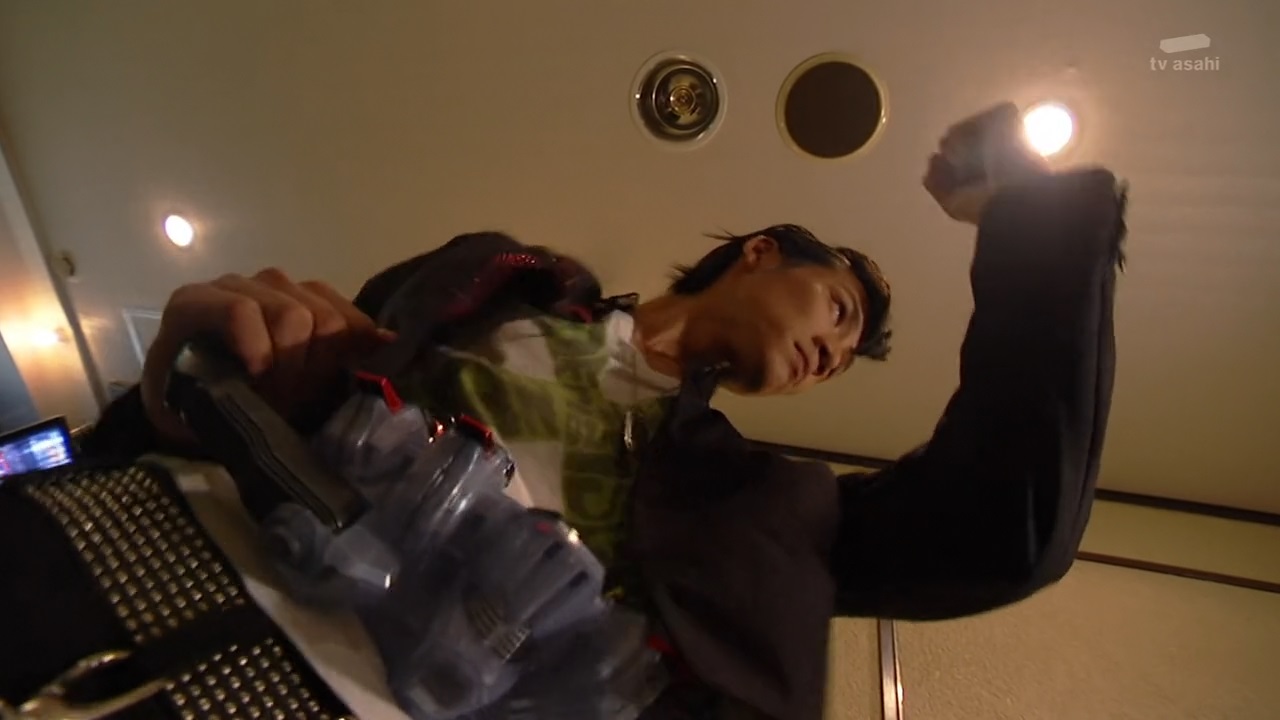
"Now dance the Rondo Towards Destruction!" (18:20)
The Japanese line is "Hametsu he no Rondo wo odorinasai!" (破滅への輪舞曲を踊りなさい!). This is referencing Atobe Keigo (跡部景吾) from "Tenisu no Oujisama" (テニスの王子様), "The Prince of Tennis", a manga series written by Konomi Takeshi (許斐剛) and published from 1999 to 2008. In the series, one of Atobe's signature techniques is called "Hametsu he no Rondo" (破滅への輪舞曲), which translates to "Rondo Towards Destruction".
"That's one case completed!" (18:29)
The Japanese line is "Kore ni te ikken konpuriito!" (これにて一件コンプリート!). This is referencing the same line said by the Dekarangers in "Tokusou Sentai Dekaranger" when they solve a case.S2
"However, I will erase Tamao's memory." (18:57)
In the Cthulhu Mythos, when a creature of the Great Race of Yith switches minds with another creature, the victim's memory of the time its mind switched places is erased when the creature of the Great Race switches their minds back.
"Den-den-dendrobium bye-bye." (19:10)
The Japanese line is "Den den dendorobiumu de bai bai bai desu yo" (でんでんデンドロビウムでバイバイバイですョ). There are two references here:
* This is referencing the Dendrobium from "Mobile Suit Gundam 0083: Stardust Memory", an anime series released from 1991 to 1992. The Dendrobium is formed by combining Gundam "Dendrobium Stamen" and its support unit, Gundam "Dendrobium Orchis".S1
* This is referencing a line in the lyrics to "Ningen tte Ii na" (にんげんっていいな), "Humans are great huh?", a song sung by Nakajima Yoshimi (中島義実) and Young Fresh (ヤング・フレッシュ) and released in 1984. This song is the ending theme song to "Manga Nippon Mukashi Banashi" (まんが日本昔ばなし), "Japanese Folklore Cartoons", an anime series that aired from 1975 to 1995. The original line goes, "Den den dengurikaette bai bai bai" (でんでんでんぐりかえって バイバイバイ), which translates to "Tum-tum-tumbling bye, bye, bye".S1 (Thanks convexity for translation help)
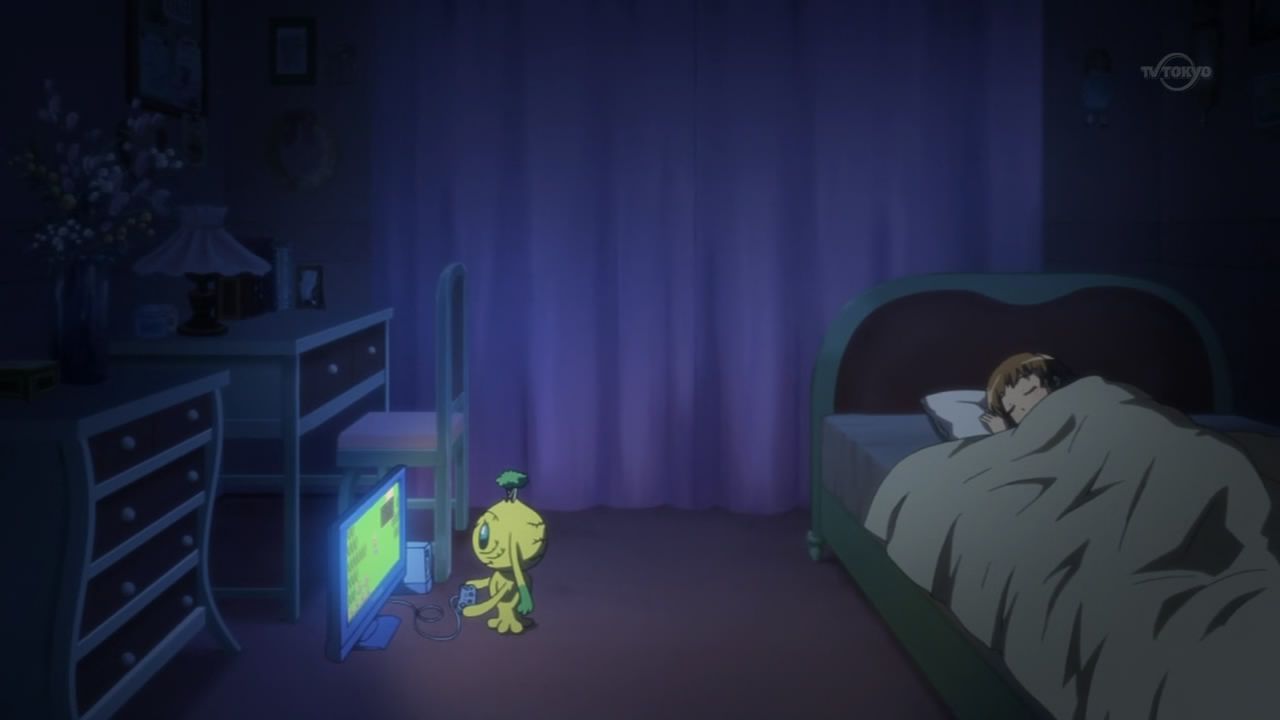
(19:40)
Yithka's appearance here is referencing the bodies inhabited by creatures of the Great Race of Yith after they leave Earth in the far future. This matches how Yithka says she's from the future where the Earth is already destroyed.S1 In "The Shadow Out of Time", a story written by H. P. Lovecraft and first published in 1936, the following is stated:
"Later, as the earth's span closed, the transferred minds would again migrate through time and space—to another stopping-place in the bodies of the bulbous vegetable entities of Mercury."
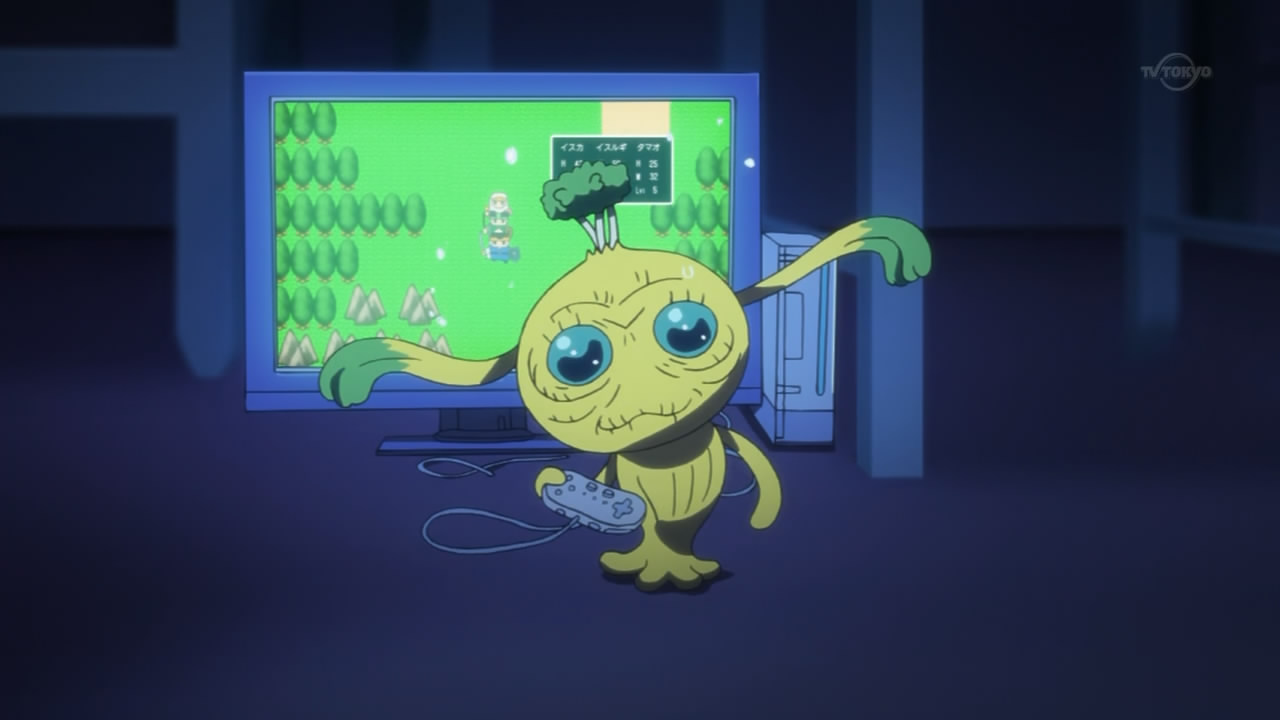
(19:45)
There are two references here:
* The video game console is based on the Nintendo Wii (ウィー), a video game console released by Nintendo (任天堂) in 2006. In addition, Yithka is using a Wii Classic Controller.S1 Images for reference:


Image sources:
https://en.wikipedia.org/wiki/File:Wii_console.png
https://en.wikipedia.org/wiki/File:Wii-Classic-Controller-White.jpg
* The game Yithka is playing is referencing "Dragon Quest II: Luminaries of the Legendary Line" (ドラゴンクエストII 悪霊の神々), a game first released in 1987.S1 In particular, because the console Yithka is playing the game on is referencing the Wii, the game is likely also referencing "Dragon Quest 25th Anniversary Collection" (ドラゴンクエスト25周年記念 ファミコン&スーパーファミコン ドラゴンクエストI・II・III), a game released for the Wii in 2011 that contains "Dragon Quest" 1, 2, and 3.S2
* On a side note, the names of the characters in Yithka's party are Yithka (イスカ), Isurugi (イスルギ), and Tamao (タマオ).S3
(23:43)
The lines at this time go as follows:
珠緒: 「なんでも、かわいい三姉妹が居候的に転がりこんで来るらしいよ」These lines are referencing "Papa no Iu Koto wo Kikinasai!" (パパのいうことを聞きなさい!), "Listen to Me, Girls. I Am Your Father!", a light novel series written by Matsu Tomohiro (松智洋) and published starting from 2009.S1
余市: 「あれ、なんだか俺が主役の予感」
余市: 「八坂くんの言う事を聞いてほしいな」
Tamao: "Nan demo, kawaii sanshimai ga isourou teki ni korogari konde kuru rashii yo"
Yoichi: "Are, nan da ka ore ga shuuyaku no yokan"
Yoichi: "Yasaka-kun no iu koto wo kiite hoshii na"
Tamao: "It seems like three cute little sisters are going to come rolling in."
Yoichi: "Oh? Am I going to be the star?"
Yoichi: "I wish you would listen to Yasaka."
* Tamao's line is referencing the premise of the series. The main character of the series is Segawa Yuuta (瀬川祐太). One day he is asked to babysit his older sister's three daughters. Due to extenuating circumstances these three sisters end up living with him.
* Yoichi's first line about being the star is referencing how his voice actor, Hatano Wataru (羽多野渉), also voices Yuuta in the anime adaptation that aired in 2012. On a related note, the voice actor who voices Mahiro, Kitamura Eri (喜多村 英梨), also voices one of the sisters, Takanashi Miu (小鳥遊美羽), in the anime adaptation.
* Yoichi's last line is referencing the title, "Papa no Iu Koto wo Kikinasai!", which translates to "Listen to what your father says!".
(23:51)
The title of the next episode is "Hoshi kara otozureta mayoigo" (星から訪れた迷い子), which translates to "The Lost Girl from the Stars". This is referencing "The Shambler from the Stars", a short story written by Robert Bloch and first published in 1935. This story was translated into Japanese with the title "Hoshi Kara Otozureta Mono" (星から訪れたもの).S1
List of sources:
S1. Comments on this post
S2. A post at Steman Blog (ステマブログ)
S3. Japanese Nyaruko References Wiki (這いよれ! ニャル子さん 元ネタwiki) - Nyaruko Episode 10
S4. A blog by servitors about Cthulhu Mythos inspired works (クトゥルー/クトゥルフ神話作品発掘記)
S5. Japanese Nyaruko References Wiki (這いよれ! ニャル子さん 元ネタwiki) - Nyaruko Light Novel Series Volume 3, Chapter 4
Thanks to everyone who contributed! This list wouldn't be nearly as long without you all. See you next episode!
情報を教えてくださって本当にありがとうございました!皆さんがいなかったら、このリストはぜんぜん長くありません。またこの次までね!
Last updated July 16, 2012
Sitemap
Home
